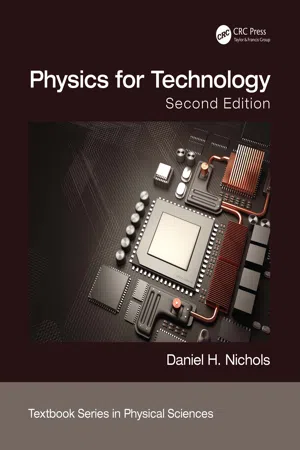
This is a test
- 410 pages
- English
- ePUB (mobile friendly)
- Available on iOS & Android
eBook - ePub
Physics for Technology, Second Edition
Book details
Book preview
Table of contents
Citations
About This Book
This text provides an introduction to the important physics underpinning current technologies, highlighting key concepts in areas that include linear and rotational motion, energy, work, power, heat, temperature, fluids, waves, and magnetism. This revision reflects the latest technology advances, from smart phones to the Internet of Things, and all kinds of sensors. The author also provides more modern worked examples with useful appendices and laboratories for hands-on practice. There are also two brand new chapters covering sensors as well as electric fields and electromagnetic radiation as applied to current technologies.
Frequently asked questions
At the moment all of our mobile-responsive ePub books are available to download via the app. Most of our PDFs are also available to download and we're working on making the final remaining ones downloadable now. Learn more here.
Both plans give you full access to the library and all of Perlego’s features. The only differences are the price and subscription period: With the annual plan you’ll save around 30% compared to 12 months on the monthly plan.
We are an online textbook subscription service, where you can get access to an entire online library for less than the price of a single book per month. With over 1 million books across 1000+ topics, we’ve got you covered! Learn more here.
Look out for the read-aloud symbol on your next book to see if you can listen to it. The read-aloud tool reads text aloud for you, highlighting the text as it is being read. You can pause it, speed it up and slow it down. Learn more here.
Yes, you can access Physics for Technology, Second Edition by Daniel H. Nichols in PDF and/or ePUB format, as well as other popular books in Physical Sciences & Physics. We have over one million books available in our catalogue for you to explore.
1
Units and Measurements
Units are based on standards wherein we define measurable quantities, such as length, mass, time, and so on. The units vary depending on the size of things we are measuring. For example, we would not measure the distance across the United States in inches; that is much too small a unit. Instead we would use a unit such as miles or kilometers. It is very handy to be able to convert back and forth between like units, such as miles, inches, and kilometers. This chapter will present some of the various ways of measuring, recording, and converting between units (Figure 1.1).

FIGURE 1.1 Measuring instruments.
1.1 SCIENTIFIC NOTATION
Many measurements are written in scientific notation, which is a method of writing big and small numbers in a compact way. In this notation, all numbers are written in a power of ten.
The number above the ten is called an exponent, which tells how many zeros come after the one.
For numbers such as 1/10 or 1/100, we use a minus sign in the exponent.
The number in the exponent now tells how many zeros follow the one at the bottom of the fraction.
Numbers such as 638,000 or 0.00012 can be written in scientific notation.
Place the decimal after the first nonzero digit on the left and count the number of places the decimal was moved over. Use that number in the exponent. If the decimal is moved to the left, the exponent is positive. If the decimal is moved to the right, the exponent is negative.
1.2 UNITS OF LENGTH
In the English system, length units are miles, yards, feet, and inches. Another system is the SI system. SI stands for the Système International (International System, in English). The metric system is part of the SI system. The basic unit of length in SI is meter. All units of length are based on it.
In the early part of the twentieth century, the standard of measuring length was defined using a metal bar that was kept in a vault in France. To calibrate a meter stick, one would have to travel to France and compare the two. This was very inconvenient! It therefore became necessary to devise a generic method of measuring length so that the whol...
Table of contents
- Cover
- Half Title
- Series Page
- Title Page
- Copyright Page
- Dedication Page
- Table of Contents
- Preface
- Acknowledgements
- Author
- Chapter 1 Units and Measurements
- Chapter 2 Linear Motion
- Chapter 3 Force and Momentum
- Chapter 4 Energy, Work, and Power
- Chapter 5 Rotational Motion
- Chapter 6 Machines
- Chapter 7 Strength of Materials
- Chapter 8 Fluids
- Chapter 9 Fluid Flow
- Chapter 10 Temperature and Heat
- Chapter 11 Thermodynamics: Heat Engines, Heat Pumps, and Thermal Expansion
- Chapter 12 Electric Force
- Chapter 13 Electricity
- Chapter 14 Magnetism
- Chapter 15 Waves
- Chapter 16 Light
- Chapter 17 Data Acquisition-Sensors and Microcontrollers
- Chapter 18 Smartphones and Physics
- Appendix A: Trigonometry Review
- Appendix B: Supplementary Lab Experiments
- Appendix C: Unit Conversions
- Appendix D: Answers to Odd Numbered Back of the Chapter Problems
- Index